.png.transform/rendition-xs/image_image%20(1).png)
Basque Pintxos Touring in San Sebastián
If you are looking for a green, peaceful city on the coast surrounded by mountains, with breathtaking views and excellent food, there is a place called San Sebastián. This enchanting city, very close to the French border, will stun every visitor with the splendor of its Concha beach, said to be the most beautiful bay in Europe. On top of that, San Sebastián is believed to be the culinary capital of Spain as it has the most Michelin stars per capita in the world. What really makes it a special place for foodies, however, is its lively pintxo culture
Pintxos, what are they? It’s the Basque spelling that makes the word look rather peculiar, as the same word written in Spanish as ‘pincho’ does show more resemblance to the verb it comes from, 'pinchar', which means 'to pierce'. Pinchos are traditionally pierced with a toothpick to attach them to the piece of bread they sometimes still come attached to, hence the name pintxo to refer to the bite as a whole.
I still remember the very first time I went for pintxos in San Sebastián, back then as a tourist, and how I was asked to count my toothpicks when I had finished my fill of the delicious cold pintxos displayed on the top of the bar. I was surprised how easily these barmen trusted the crowd to be honest enough to pay for the exact amount of pintxos and wine they had had. I soon learned it is an essential part of the friendly culture and atmosphere in this city. Many bars have windowsills especially designed to leave your glasses on so people can have their drink and delicious bite both inside and outside the bar.
A culinary crawl
The pintxo culture especially thrives in the heart of the city, the parte vieja or old town, where one bar leads to another. As you walk down the pedestrian streets of this charming barrio, you can easily glimpse inside the bars. In most of them you will spot an abundance of colourful cold pintxos on the bar counter. It soon makes you understand the difference between these Basque pintxos and Spanish tapas. With pintxos, it is not only about food and flavour but also about presentation. The Basques like to add colour to their bite-sized delicacies, finishing off a bread-pintxo with a beautiful red pepper on top or adding a sprinkling of parsley.
Other bars, however, don’t display anything but this doesn’t mean there are no pintxos on offer. They are simply more modern bars who have made it their specialty to serve only hot ‘mini-gastronomic dishes’. Borda Berri is a good example of such a bar. The bartenders there are constantly trying to keep the counter spotless but at the back you will see a tiny little kitchen where the bar’s famous treasures are wonderfully cooked and prepared. These hot pintxos or delicacy dishes are usually written in chalk on a blackboard on the wall. It is wise not to order more than one or two of these pintxos at a time. They are generally served quickly and the secret to going for pintxos is that you have just a few pintxos in one bar, together with one or two glasses of wine, and then move on to another bar.
It is almost like a culinary bar crawl, and there are many advantages. As opposed to eating in a restaurant, you don’t have to wait very long to be served; you are free to eat as much as you like and at the same time get to taste many different flavours. When you feel a little tipsy, the walk between one bar and the next will do you good. The whole experience is a very social event as the pintxo sampling is usually done standing up or perhaps seated on a stool at the bar. Even if there are tables, they will often be communal. It is a pleasant experience to share, taste and talk at the same time. And have good wine of course.
At ‘rush hour’, especially at weekends between 9 and 11pm, these bars get especially crowded and noisy as everyone is chatting away while the bartenders busily fill up glasses with wine or cider and call out the names of pintxos that have just been sent from the kitchen. The inhabitants of the city call this ‘a good night out’ and the great thing about it is that it appeals to all age groups. Who doesn’t like to have a yummy bite in good company, after all?
Going for pintxos can be your full dinner experience for the night but it doesn’t have to be. Many locals in fact meet up with friends for just a glass of wine and a pintxo and then head home for their family lunch or dinner. It’s all very flexible.
‘Star Pintxo'
Probably the trickiest part of going for pintxos is choosing what to have. Tourists who get easily overwhelmed by all the food displayed in front of them sometimes ask for a plate, which they then fill with pintxos from the counter as from a cold buffet. This is not how it should be done according to many Basques, as the tradition is to hop from bar to bar. And although the quality of the food is usually good everywhere, each bar tends to have its own specialty or pintxo ‘estrella’ (‘star’ pintxo).
As a gastronomic guide working for San Sebastian Food, which organises culinary tours, I have helped many tourists to order the right pintxo in each bar. Prawns, for example, are often on the pintxo menu but it is important to know in which bar the best-tasting gambas are to be found. It is in Goiz-Argi, a small family-run bar with a nice open kitchen where you can see your prawns being grilled to perfection, topped off with the perfect pepper garnish. Astelehena is another bar where you can see the chefs busily at work in the kitchen, with some excellent meat and fish pintxos or, for example, a mini-risotto with a delightful goat’s cheese flavour and little bits of sun-dried tomato. It has an endless variety of brochettes to choose from on the counter, after which they are put on the grill and served.
If I had to choose the most popular ingredient for Basque pintxos, apart from peppers I would most certainly mention the anchovy. In the old town of San Sebastián the Mecca of anchovy is no doubt Txepetxa. Proof of this bar’s fame are the many framed pictures on the wall with famous people on them - often actors or directors who were in the city for the International Film Festival - posing with one of the bar’s most traditional pintxos which has anchovy exquisitely combined with other ingredients such as foie gras and some very tasty apple sauce.
The perfect blend of flavours is actually the key element to a successful pintxo. This could, for instance, be a strong contrast between salty and sweet. The most traditional of Basque pintxos can rightly be called an ‘explosion of flavours’ as it combines the anchovy, the olive and the pickled guindilla (local green pepper) pierced on one toothpick. These three ingredients were sampled together almost by coincidence in one of the oldest bars of the city, where the bartender used to serve olives, anchovies or guindillas with his wine. One day these were pierced together on one toothpick by a group of friends who had gathered together in that bar.
Today this traditional ‘gilda’, as it was called, will be found on the counter of almost every self-respecting traditional bar, and in the summer months there will also be a big bowl of fresh guindillas. After grilling these green peppers in hot olive oil for just a couple of minutes, they are served on a plate with thick salt sprinkled on them. They are the perfect pintxo snack to be devoured together with friends and a glass of txakoli wine, a fresh white Basque wine.
A mix of modern and tradition
It is hard to get bored when going for pintxos in San Sebastián, even if you have been many times already. There are probably more than one hundred bars in the town and the world of pintxos is in constant evolution. In recent years, avant-garde pintxos have become more popular, with a mix of experimental techniques and traditional recipes. An outstanding example of this is the bar of Zeruko, where the pintxos displayed on the counter are a feast for the eye and palate. One of the desserts there, for example, is presented as a traditional dish, fried egg with chorizo, but the yolk has in fact a mango flavour. Other modern pintxo dishes come with instructions or surprising ‘special effects’. However stunning these may be, many locals prefer to stick to the flavours of their ‘good old’ traditional pintxos (‘los de siempre’). The Basques are known to be loyal and are especially so when it comes to traditional recipes. Perhaps that explains in part why gastronomy has become the trademark of this part of Spain.
Apart from tradition though, the Basques invest a lot in innovation too. Many pintxo bars usually take part in annual competitions and will proudly display their medals on the walls. The winning pintxos are then to be found written in chalk on the blackboard, so that customers can judge the new creation by the kitchen’s chef themselves.
The pintxo bars of San Sebastián are good places to be. For just a couple of Euros you can taste a piece of haute cuisine or simply a home-made tortilla de patatas (potato omelette), which you share with the other guests at the table. You can have the greatest mushrooms in the traditional bar of Ganbara or you can go for a few mussels perhaps in that special bar in the old town, famous for the sauce it serves them with. If you ask one of the bartenders for the secret recipe of the sauce which has made this bar so popular, he will look at you and say that ‘he is very sorry but his lips are sealed’. Still, it is wonderful to discover all those little secrets of success coming from the pintxo bar kitchens in San Sebastián, in just one or two sensational bites.
Text: Emmie Declerck
Pintxos, what are they? It’s the Basque spelling that makes the word look rather peculiar, as the same word written in Spanish as ‘pincho’ does show more resemblance to the verb it comes from, 'pinchar', which means 'to pierce'. Pinchos are traditionally pierced with a toothpick to attach them to the piece of bread they sometimes still come attached to, hence the name pintxo to refer to the bite as a whole
Emmie Declerck/©ICEX
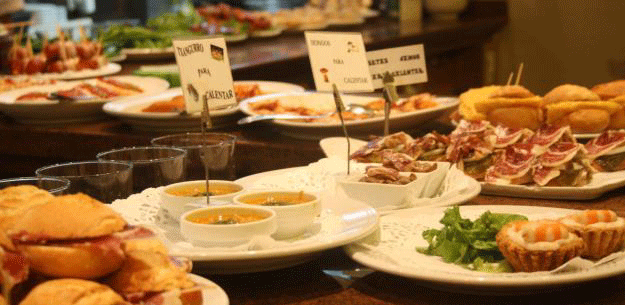
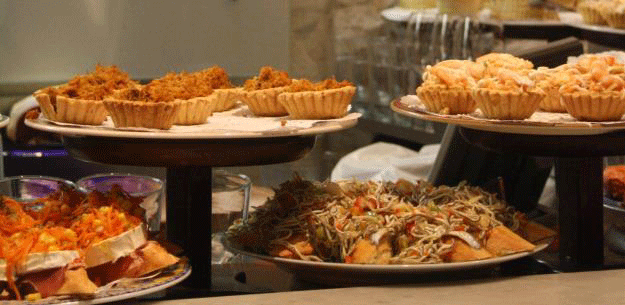
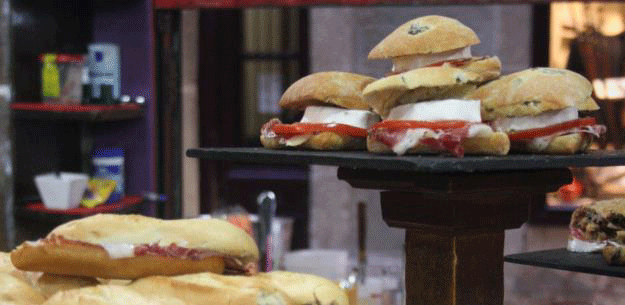
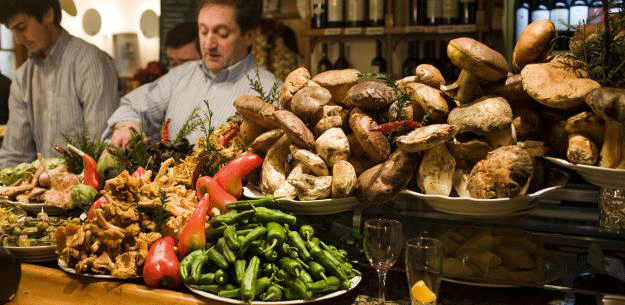
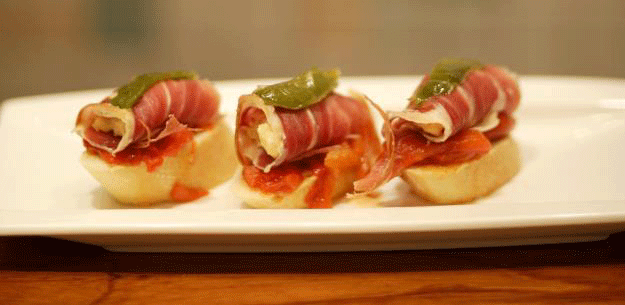
- Image1
- Image2
- Image3
- Image4
- Image5


